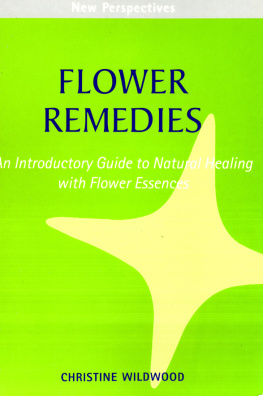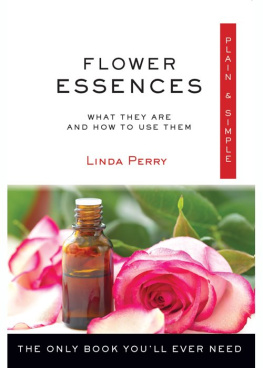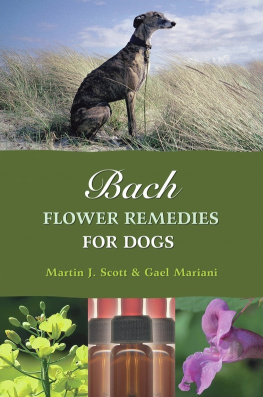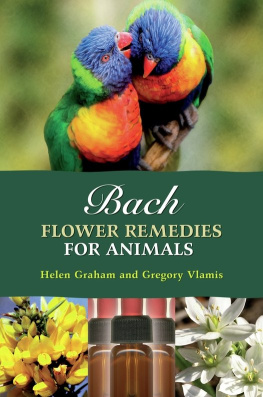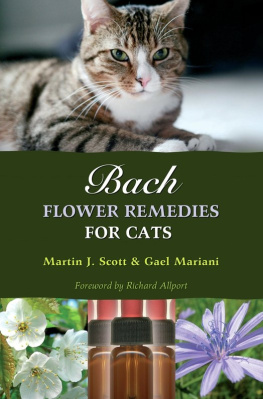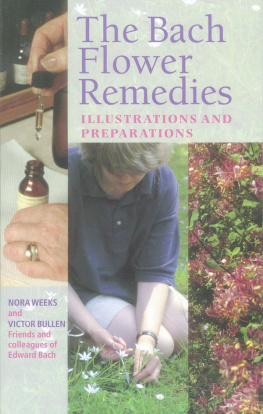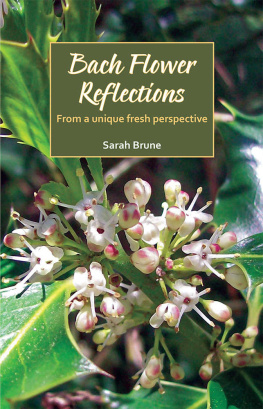Christine Wildwood is an internationally renowned aromatherapist, lecturer and author and has written numerous books on Aromatherapy and health-related subjects. She also conducts workshops on Aromatherapy, deep relaxation and meditation. She lives in South Wales and runs a very popular Aromatherapy and holistic health practice from her home.
New Perspectives series
New Perspectives provide attractive and accessible introductions to a comprehensive range of mind, body, and spirit topics. Beautifully designed and illustrated, these practical books are written by experts in each subject.
Books in the series:
Alexander Technique, Richard Brennan
Aromatherapy, Christine Wildwood
Crystal Therapy, Stephanie and Tim Harrison
Dreams, David Fontana
Flower Remedies, Christine Wildwood
Herbal Remedies, Vicki Pitman
Homeopathy, Peter Adams
Nutritional Therapy, Jeannette Ewin
New Perspectives
FLOWER
REMEDIES
An Introductory Guide to
Natural Healing with Flower
Essences
CHRISTINE WILDWOOD

CONTENTS
ACKNOWLEDGEMENTS
With many thanks to all at Mount Vernon and to everyone else who contributed in some way to the birth of this book. And to Dr Edward Bach whose shining spirit lives on through his work.
NOTE FROM THE PUBLISHER
Any information given in any book in the New Perspectives series is not intended to be taken as a replacement for medical advice. Any person with a condition requiring medical attention should consult a qualified medical practitioner or suitable therapist.

WHAT ARE THE BACH FLOWER REMEDIES?
CHAPTER ONE
T he 38 Flower Remedies that comprise the Bach Flower pharmacopoeia are made from wild flowers that have been carefully selected for their special ability to promote self-healing. For nearly 60 years, wild flowers have been selected and prepared at the Bach Centre at Mount Vernon, Oxfordshire, England, to make these beautiful healing remedies. It was here that the visionary physician Edward Bach lived and worked.

FRESHLY PICKED WILD FLOWERS ARE USED TO MAKE THE BACH REMEDIES. PLANTS GROWING IN THE WILD HAVE BEEN NURTURED BY THE LIVING EARTH.
Dr Edward Bach (18861936) studied medicine and worked as a bacteriologist and homeopath. He became convinced, however, that poisonous substances of animal, plant or mineral origin should play no part in healing not even when used in infinitesimal doses as in homeopathy. Much to the chagrin of the British medical establishment, he was inspired (for there is no other word for it) to give up his lucrative London practice and move to North Wales to seek a completely new form of healing one that was totally benign to both humans and animals.
Bachs homeopathic background had made him aware that highly diluted medicinal substances, so diluted that the original material cannot be detected in the laboratory, can trigger a powerful healing effect in the body. This knowledge was to influence the development of his own system of healing. Equally important to Bach was the realization that long-term stress resulting from emotions such as anger, fear or worry lowered a persons resistance to disease, making the body prey to all manner of infection or illness. Moreover, he believed that an individuals emotional outlook influenced the course, severity and duration of their disease. He also noticed that people suffering from the same disease and sharing similar personalities responded well to a particular remedy, but that others of a varying temperament needed different treatment, although they were suffering from the same physical complaint. Thus Bachs axiom became, Take no notice of the disease, think only of the personality of the one in distress.

THE OLIVE TREE PROVIDES THE RAW MATERIAL TO MAKE A REMEDY FOR SPIRITUAL RENEWAL AND THE PROPER USE OF ENERGY.
Bach was essentially guided by intuition, or what some might call divine inspiration. He believed strongly that the key to the art of true healing lay not in the laboratory but within the plant kingdom, and that these special plants could be found growing wild, nurtured by the living Earth and energized by the synergy of fresh air, water and sunlight.
According to Bach, certain flowers are of a higher order and hold a greater power than those ordinary medicinal plants that heal the body from a biochemical level. The true healing plants, he believed, address disharmony within the mental and spiritual aspects of our being. They transmute negative emotions such as fear, melancholy, and hatred into courage, joy, and love; and in this manner, they correct the cause of our ills.
A SIMPLE METHOD OF POTENTIZATION
Bach believed that the early morning dew that rested upon a flower must contain some of its vital properties. He tested his theory by collecting the dew from certain flowers and trying it out on himself. Through his finely developed senses, he found that the dew held a definite power of some kind. Moreover, dew collected from flowers exposed to sunlight was far more potent than that collected from flowers growing in the shade. Bach also found that the essential energies of a plant were concentrated in the flower at full maturity, that is, when it has reached its peak of perfection and is about to fall.
Since collecting large amounts of dew was obviously impractical, Bach devised two methods to enable him to extract the healing properties of plants in the quantities required. These two methods of extraction or potentization as Bach preferred to call it are known as the Sun Method and the Boiling Method.
In the Sun Method, the best flower heads are carefully picked. These are then put in a thin, clear glass or crystal bowl filled with spring water. The bowl is then placed on the ground (near the parent plants) where it is exposed to strong sunlight for a few hours. The flowers are then carefully removed with a twig or leaf, thus avoiding human contact with the vitalized water or essence. The essence is then poured into bottles that are half-filled with brandy (which acts as a preservative). This is known as the Mother Tincture.

THE SUN METHOD OF GENTLE POTENTIZATION INVOLVES PLACING FLOWER HEADS IN SPRING WATER AND ALLOWING THE SUN TO DO ITS WORK.

THE BOILING METHOD OF EXTRACTION, IN WHICH THE MATERIAL IS SIMMERED IN SPRING WATER, WAS DEVELOPED BY BACH FOR CERTAIN TYPES OF PLANT.
For blooms, such as Star of Bethlehem, Willow and Elm, that required a stronger method of extraction, Bach devised the Boiling Method. With this method, plant material, such as buds, cones or flowers, is placed in an enamel pan of spring water and simmered for half-an-hour. Afterwards, the pan is covered and left to cool. Then, when cold, the essence is filtered and, as in the previous method, preserved in equal quantities of brandy and labelled Mother Tincture.
Next page
